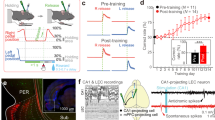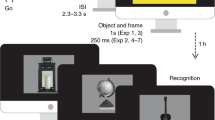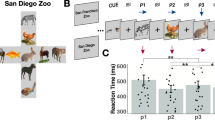Abstract
The role of the hippocampus in goal-directed action is currently unclear; studies investigating this issue have produced contradictory results. Here we reconcile these contradictions by demonstrating that, in rats, goal-directed action relies on the dorsal hippocampus, but only transiently, immediately after initial acquisition. Furthermore, we found that goal-directed action also depends transiently on physical context, suggesting a psychological basis for the hippocampal regulation of goal-directed action control.
This is a preview of subscription content, access via your institution
Access options
Access Nature and 54 other Nature Portfolio journals
Get Nature+, our best-value online-access subscription
$29.99 / 30 days
cancel any time
Subscribe to this journal
Receive 12 print issues and online access
$209.00 per year
only $17.42 per issue
Buy this article
- Purchase on Springer Link
- Instant access to full article PDF
Prices may be subject to local taxes which are calculated during checkout


Similar content being viewed by others
Data availability
Research data for this article (Figs. 1 and 2 and Extended Data Figs. 2–4) are available for download at https://osf.io/vd4an/?view_only=b161002919a24ca196ce23f7b2df84ad/.
References
Vikbladh, O. M. et al. Hippocampal contributions to model-based planning and spatial memory. Neuron 102, 683–693 (2019).
Schuck, N. W. & Niv, Y. Sequential replay of nonspatial task states in the human hippocampus. Science 364, eaaw5181 (2019).
Wikenheiser, A. M. & Redish, A. D. Hippocampal theta sequences reflect current goals. Nat. Neurosci. 18, 289–294 (2015).
Zhou, J. et al. Complementary task structure representations in hippocampus and orbitofrontal cortex during an odor sequence task. Curr. Biol. 29, 3402–3409 (2019).
Corbit, L. H. & Balleine, B. W. The role of the hippocampus in instrumental conditioning. J. Neurosci. 20, 4233–4239 (2000).
Corbit, L. H., Ostlund, S. B. & Balleine, B. W. Sensitivity to instrumental contingency degradation is mediated by the entorhinal cortex and its efferents via the dorsal hippocampus. J. Neurosci. 22, 10976–10984 (2002).
Dickinson, A. & Balleine, B. Motivational control of instrumental action. Curr. Dir. Psychol. Sci. 4, 162–167 (1995).
Dickinson, A. Instrumental conditioning. in Animal Learning and Cognition (ed. Mackintosh, N. J.) 45–79 (Academic Press, 1994).
Laurent, V., Chieng, B. & Balleine, B. W. Extinction generates outcome-specific conditioned inhibition. Curr. Biol. 26, 3169–3175 (2016).
Bradfield, L. A., Dezfouli, A., Van Holstein, M., Chieng, B. & Balleine, B. W. Medial orbitofrontal cortex mediates outcome retrieval in partially observable task situations. Neuron 88, 1268–1280 (2015).
Fanselow, M. S. & Dong, H. W. Are the dorsal and ventral hippocampus functionally distinct structures? Neuron 65, 7–19 (2010).
Thrailkill, E. A. & Bouton, M. E. Contextual control of instrumental actions and habits. J. Exp. Psychol. Anim. Learn. Cogn. 41, 69–80 (2015).
Russell, W. R. & Nathan, P. W. Traumatic amnesia. Brain 69, 280–300 (1946).
Scoville, W. B. & Milner, B. Loss of recent memory after bilateral hippocampal lesions. J. Neurol. Neurosurg. Psychiatry 20, 11–21 (1957).
Vargha-Khadem, F. et al. Differential effects of early hippocampal pathology on episodic and semantic memory. Science 277, 376–380 (1997).
Tulving, E. & Markowitsch, H. J. Episodic and declarative memory: role of the hippocampus. Hippocampus 8, 198–204 (1998).
Kim, J. J. & Fanselow, M. S. Modality-specific retrograde amnesia of fear. Science 256, 675–677 (1992).
Schafe, G. E., Nader, K., Blair, H. T. & LeDoux, J. E. Memory consolidation of Pavlovian fear conditioning: a cellular and molecular perspective. Trends Neurosci. 24, 540–546 (2001).
Gershman, S. J. & Daw, N. D. Reinforcement learning and episodic memory in humans and animals: an integrative framework. Annu. Rev. Psychol. 68, 101–128 (2016).
Verschure, P. F. M. J., Pennartz, C. M. A. & Pezzulo, G. The why, what, where, when and how of goal-directed choice: neuronal and computational principles. Philos. Trans. R. Soc. Lond. B Biol. Sci. 369, 20130483 (2014).
Paxinos, G. & Watson, C. Paxinos and Watson’s The Rat Brain in Stereotaxic Coordinates (Elsevier Academic Press, 2014).
Kosaki, Y. & Dickinson, A. Choice and contingency in the development of behavioral autonomy during instrumental conditioning. J. Exp. Psychol. Anim. Behav. Process. 36, 334–342 (2010).
Hays, W. L Statistics for the Social Sciences (Holt, Rinehart & Winston, 1973).
Acknowledgements
We thank G. Hart for helpful discussions and F. Westbrook for feedback on the manuscript. This work was supported by grants GNT1087689 and GNT1148244 from the National Health and Medical Research Council in Australia to L.A.B. and B.W.B.
Author information
Authors and Affiliations
Contributions
L.A.B., B.K.L. and B.W.B. designed the experiments. L.A.B., B.K.L., S.L. and S.B. performed the experiments. L.A.B., B.K.L. and B.W.B. wrote the manuscript.
Corresponding authors
Ethics declarations
Competing interests
The authors declare no competing interests.
Additional information
Peer review information Nature Neuroscience thanks Stan Floresco, Geoffrey Schoenbaum and Nicolas Schuck for their contribution to the peer review of this work.
Publisher’s note Springer Nature remains neutral with regard to jurisdictional claims in published maps and institutional affiliations.
Extended data
Extended Data Fig. 1 Cannula and DREADDs placements.
a, Diagrammatic representation of cannula placements from Experiment 1a (indicated by black dots). b, Photomicrograph of representative cannula placement (n = 24 rats with similar placements in Experiment 1a). c, Diagrammatic representation of cannula placements from Experiment 1b (indicated by black dots). d, Diagrammatic representation of CA1/Dorsal hippocampal viral DREADDs placements (indicated in red), showing each overlapping placement for Experiment 2. e, Diagrammatic representation of CA2 viral DREADDs placements (indicated in red), showing each overlapping placement for Experiment 2. f, Diagrammatic representation of dorsal hippocampal viral placements (indicated in red), showing each overlapping placement for Experiment 3a. g, Diagrammatic representation of dorsal hippocampal viral placements (indicated in red), showing each overlapping placement for Experiment 3b. All placements are shown on coronal sections adapted from the rat brain atlas of Paxinos & Watson21.
Extended Data Fig. 2 Supplementary experimental data for Experiments 1-3.
a, Mean presses per day during polycose pretraining for Experiment 1a. b, Mean presses on Day 6 of lever press training (pellets and sucrose delivered) for Experiment 1a (n = 19 rats). c, Mean pellet and sucrose deliveries on Day 6 in Experiment 1a (n = 19 rats). d, Mean presses per day during polycose pretraining for Experiment 1b (n = 16 rats). e, Mean presses on Day 6 of lever press training (pellets and sucrose delivered) for Experiment 1b (n = 16 rats). f, Mean pellet and sucrose deliveries on Day 6 in Experiment 1b (n = 16 rats). g, Mean presses during initial acquisition for Experiment 2 (n = 35 rats). h, Mean pellet and sucrose deliveries during initial acquisition for Experiment 2 (n = 35 rats). i, Mean presses per day during extended training for Experiment 2 (n = 35 rats). Although training performance in the hM4Di groups did not differ across days (largest F(1,31) = 1.06, p = .311), linear acquisition was significantly reduced for group mCherry+CNO relative to group hM4Di+Veh, F(1,31) 6.297, p = .018. These data were analyzed using orthogonal complex contrasts, controlling the per-contrast error rate at α = 0.05. j, Mean presses during initial acquisition for Experiment 3a (Immediate devaluation; n = 38 rats) and 3b (Delayed Devaluation; n = 37 rats). k, Mean pellet and sucrose deliveries during initial acquisition for Experiment 3a (n = 38 rats). l, Mean pellet and sucrose deliveries during initial acquisition for Experiment 3b (n = 37 rats). Data are shown as individual dot plots and mean ± SEM.
Extended Data Fig. 3 Supplementary experimental data for Experiments 4-5.
a, Mean presses per day during polycose pretraining for Experiment 4a (n = 25 rats). b, Mean presses on Day 6 of lever press training (pellets and sucrose delivered) for Experiment 4a (n = 25 rats). c, Mean pellet and sucrose deliveries on Day 6 in Experiment 4a (n = 25 rats). d, Mean presses per day during instrumental training (pellets and sucrose delivered) for Experiment 4b (n = 21 rats). e, Mean presses during initial acquisition for Experiment 5 (n = 26 rats). f, Mean pellet and sucrose deliveries during initial acquisition for Experiment 5 (n = 26 rats). Data are shown as individual dot plots and mean ± SEM.
Extended Data Fig. 4 Suppression ratios on devalued vs. valued lever on test for each experiment.
a, Suppression ratios for Experiment 1a (n = 19 rats). There was no main effect of group, F(1,17) = 1.583, p = .225, but there was a group x lever interaction, F(1,17) = 4.672, p = .045. However, neither lever simple effect was significant, largest p = .12 (on devalued lever, this result suggests group rather than lever simple effects comprise this interaction). b, Suppression ratios for Experiment 1b (n = 16 rats). There was a main effect of group, F(1,14) = 6.316, p = .025, but this did not interact with lever, F(1,14) = 3.808, p = .071, suggesting that overall responding was suppressed in group MUSCIMOL relative to group SALINE, but this was not specific to either lever. c, Suppression ratios for the initial test in Experiment 2 (n = 35 rats). There was no main effect of group, F < 1, but there was a group x lever interaction, F(1,31) = 5.603, p = .024. Once again this interacted was composed of group simple effects because neither lever simple effect was significant (largest p = .225 on devalued lever). d, Suppression ratios for the extended test in Experiment 2. There were no statistical differences between groups or levers, all Fs < 1. e, Suppression ratios for Experiment 3a (n = 38 rats). There were no main effects or interactions when controls were compared to M4+CNO (that is the analysis used in Fig. 1i). If animals that received training and test injections were analyzed separately, there was a main effect of group for test-injected animals, F(1,34) = 7.919, p = .008, that did not interact with lever, F < 1, indicating that group M4+CNO suppressed responding less than controls but this was not specific to either lever. For animals that received training injections, all Fs < 1. f, Suppression ratios for Experiment 3b (n = 37 rats). There were no statistical differences between groups or levers, all Fs < 1.21. g, Suppression ratios for Experiment 4a (n = 25 rats). There were no statistical differences between groups or levers, all Fs < 1. h, Suppression ratios for Experiment 4b (n = 21 rats). There were no statistical differences between groups or levers, all Fs < 1. i, Suppression ratios for Experiment 5 (n = 26 rats). There was no main effect of IMM-DIFF vs. Rest, F(1,22) = 1.68, p = .208. There was a group x lever interaction, F(1,22) = 10.306, p = .004. Follow-up simple effects reveal that this interaction was comprised of a significant group difference on the valued lever, F(1,22) = 6.417, p = .019, and not the devalued lever, F < 1. These data were analyzed using orthogonal complex contrasts, controlling the per-contrast error rate at α = 0.05. Data are shown as individual dot plots and mean ± SEM.
Supplementary information
Rights and permissions
About this article
Cite this article
Bradfield, L.A., Leung, B.K., Boldt, S. et al. Goal-directed actions transiently depend on dorsal hippocampus. Nat Neurosci 23, 1194–1197 (2020). https://doi.org/10.1038/s41593-020-0693-8
Received:
Accepted:
Published:
Issue Date:
DOI: https://doi.org/10.1038/s41593-020-0693-8
This article is cited by
-
Hippocampal representations of foraging trajectories depend upon spatial context
Nature Neuroscience (2022)
-
Ketamine activates adult-born immature granule neurons to rapidly alleviate depression-like behaviors in mice
Nature Communications (2022)
-
Complementary task representations in hippocampus and prefrontal cortex for generalizing the structure of problems
Nature Neuroscience (2022)
-
Cortical dopamine reduces the impact of motivational biases governing automated behaviour
Neuropsychopharmacology (2022)



